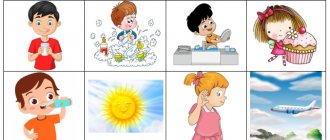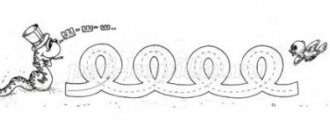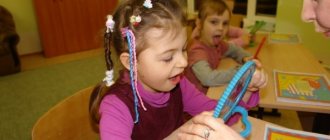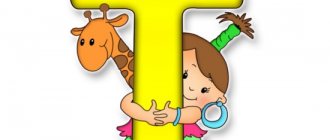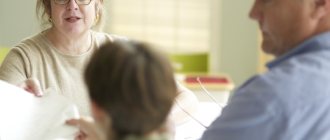Summary of individual speech therapy sessions. Automation of sound C
Summary of an individual speech therapy lesson on sound automation [C] in syllables, words and sentences
Author: Anastasia Igorevna Korogodina, teacher - speech therapist, Municipal preschool educational institution "Nursery - Garden No. 170 of the city of Donetsk" Description of work: this material will be useful for speech therapist teachers ; the material is intended for children 5 years old; This material is used in individual work on automating the sound “C” in syllables, words and sentences. Objectives: 1. Educational:
automation of the sound [S] in syllables, words and sentences.
2. Correctional:
• consolidate the skills of correct pronunciation of the sound [C] in syllables, words, sentences;
• develop articulatory and fine motor skills; • develop phonemic hearing; • develop speech breathing; • develop clarity of diction and intonation expressiveness. 3. Developmental:
• consolidate the ability to determine the place of a sound in a word;
• develop attention, memory, thinking; • practice the ability to complete a sentence grammatically correctly. 4. Educational:
• create positive motivation in the classroom;
• develop verbal communication skills and listening skills. Equipment: “Sonya the Dog” toy, “Su-Jok” massager, incentive sticker. Progress of the lesson 1. Organizational moment. Breathing exercises. Speech therapist: The bell gave us a signal: The hour has come to work. So we don’t waste time and start working. — inhale deeply through your nose, exhale through your mouth, inhale and exhale deeply again. 2. Articulation gymnastics. 1. “Smile” / “Tube” Holding your lips in a smile.
The teeth are not visible. Pulling closed lips forward. Once again. If our lips smile, Look - a fence appears.
Well, if the sponges are a narrow tube, then we can play the pipe. 2. “Clock” / “Pendulum” The mouth is slightly open.
The lips are stretched into a smile. With the tip of the narrow tongue, alternately reach to the corners of the mouth at the teacher’s count. One after another, one after another, the arrows go around in a circle.
You lick both lips, show how the arrows move. 3. “Punish the naughty tongue.” Smile widely.
Place your wide tongue on your lower lip and, lightly biting it with your teeth, say “ta-ta-ta” for 5-10 seconds. Then slap your tongue with your lips, saying “five-five-five” for 5-10 seconds. Your tongue is a mischief maker, It doesn’t listen to you.
Punish him quickly: “Five-five, five-five, five-five-five!” 4. “Pancake” The mouth is open, a wide, relaxed tongue lies on the lower lip.
We slap the tongue with our upper lip: five-five-five. We slightly bite our tongue: ta-ta-ta. In the morning we get up early and bake delicious pancakes.
The dough spreads like a stream across the frying pan... Look how beautiful the Pancake turns out. 5. “Brush your teeth” Smile, open your mouth with the tip of your tongue from the inside, “brush” the lower and upper teeth alternately.
Open your mouth, smile, show me your teeth, brush the upper and lower ones, because they are not superfluous.
6. “Gorka” Open your mouth.
Place the tip of your tongue against your lower teeth and lift the back of your tongue up. The tongue is lowered by the teeth, Its tip is pressed against the teeth.
The back arches very, very strongly - That's what a slide it turns out to be! 7. “Pussy is angry” Smile, open your mouth.
The tip of the tongue rests on the lower teeth from the inside (“mountain”). Roll out the wide tongue forward and move it deep into the mouth (slide). Repeat the exercise 8-10 times at a calm pace. Our pussy got angry: They forgot to wash her bowl.
Don't come close to her - her pussy might scratch her! 3. Finger gymnastics. Speech therapist: Look who came to us today! Who is this? This is a dog. What's the dog's name? Do not you know? I do not know either. Let's ask. Her name is Sonya. Let's introduce ourselves to Sonya, she's wondering who she'll be playing with today. Sonya loves to play with the ball. And now, we will show her how you can do it. Finger play with a “su-jok” massager.
I roll the ball in circles, I kick it back and forth.
I will stroke their palm. It’s as if I’m sweeping up a crumb, And I’ll squeeze it a little, Like a cat squeezes its paw, I’ll press the ball with each finger, And I’ll start with the other hand. Massage the fingers with an elastic ring “su-jok”.
One - two - three - four - five, /extend your fingers one at a time/ Let your fingers go out for a walk, This finger is the strongest, thickest and largest.
This finger is for showing it. This finger is the longest and stands in the middle. This ring finger is the most spoiled one. And the little finger, although small, is very dexterous and daring. 4. Articulatory image of sound. Speech therapist: Let's remember what position our lips, teeth and tongue occupy when pronouncing the sound “C”. The lips are stretched into a smile. The teeth are brought together and create a barrier to the air stream. The tip of the tongue rests on the lower teeth. 5. Pronunciation of an isolated sound [C]. Speech therapist: The dog Sonya really loves it when a cool breeze blows. Blow like a breeze S-S-S. 6. Physical education minute. We will blow high: S-S-S (The child stands on his tiptoes, raises his arms up) We will blow low: S-S-S (The child squats) We will blow far: S-S-S (The child straightens up, leans forward, arms outstretched ) We will blow close: S-S-S (Standing straight, hands raised to mouth) 7. Development of phonemic hearing. Speech therapist: Clap when you hear the sound “C”. P M S S A U K D S T S B SA MA SO BO SY AS YOU SU GI JUK SOUP SON HOUSE GARDEN SAM NOSE 8. Automation of sound (C) in pure language. Speech therapist: Imagine, our Sonya was bitten by a wasp. Now she is not friends with her. And you and I must reconcile them. We will repeat all the syllables, we will win this quarrel. SA-SA-SA, SA-SA-SA - a wasp bit me on the nose. SO-SO-SO, SO-SO-SO - my nose became like a wheel. SU-SU-SU, SU-SU-SU - I carry a wasp in my hand. SY-SY-SY, SY-SY-SY - I'm not afraid of the evil wasp. 9. Automation of sound (C) in words and sentences. Speech therapist: And now we will play the game “Sound Closet”. Name all the words. Make sure you pronounce the sound correctly.
Speech therapist: Look at the picture and say what the dog Sonya saw. Answer in a complete sentence. The dog Sonya saw...
10. Summary of the lesson. Speech therapist: What did you like most? Who did you play with today? What is the dog's name? 11. Assessment of the child’s speech activity. Speech therapist: You did great today, you pronounced the sound [S] correctly. Speech therapist: And Sonya also liked the way you played with her and performed various tasks. For this she wants to thank you and give you this sticker as a souvenir. Well done! References. 1. Yavorskaya O. N. Entertaining tasks of a speech therapist for preschoolers. – St. Petersburg: KARO, 2015. 2. Agranovich Z. E. Collection of homework for overcoming the underdevelopment of the phonemic aspect of speech in older preschoolers. To help speech therapists and parents. - St. Petersburg, 2007. 3. Zhukova N. S. Speech therapist lessons: correction of speech disorders. – M.: Eksmo, 2013. 4. Iskhanova S.V. Game therapy in speech therapy: articulatory transformations. – Rostov n/a: Phoenix, 2013.
We recommend watching:
Summary of an individual lesson on differentiating the sounds S and T for children 5-6 years old Summary of subgroup correctional activities of a speech therapist teacher with children of the senior group with FFND Summary of a speech therapy lesson in the middle group of a kindergarten: Sound and the letter P Structure of a speech therapy lesson on sound automation. Correction of sound pronunciation.
Similar articles:
Musical lesson using logorhythmics in the senior group of a preschool educational institution
MAGAZINE Preschooler.RF
Summary of individual speech therapy lesson “Sound C”Educational institution: MBDOU No. 104
Speech therapist teacher: Desh Oksana Vladimirovna
Child according to the structure of speech impairment: OHP level 4
Child's age: 5 years
Topic: Sound S.
Goal: Automation of the sound C in words and sentences.
Objectives: to consolidate the ability to form the plural of nouns, the ability to coordinate numerals with nouns, the ability to coordinate the pronouns “my” , “mine” with nouns; strengthen the ability to make sentences based on pictures.
Planned results of the lesson: correct pronunciation of the sound C in words and sentences.
Equipment: articulation gymnastics cards, game picture material, sound tracks, mirror.
Progress of the lesson.
1. Organizational moment. (2-3 minutes). Speech therapist: - Today guests came to our lesson. Let's say hello to them. Hello, we are glad to see you as our guest! Speech therapist: - Listen carefully to the poem that I will read. Snow is falling, falling from the sky.
The winter forest sleeps under the snow.
The sleepy garden stands in the snow,
He also sleeps under the snow. Speech therapist: - Tell me, please, what sound did I highlight in my voice? (sound C). Right. Today we will practice correctly pronouncing the sound C. 2. Main part. (15 minutes). Articulation analysis. Speech therapist: - Let's remember how we pronounce the sound S. What happens to the lips? Are your lips stretched into a smile? Are your teeth visible? Yes. The mouth is slightly open. Where is the tongue located? The tip of the tongue rests on the lower teeth. In the middle of the tongue there is a groove along which a strong cold stream of air flows.
Articulation gymnastics. Speech therapist: - First of all, let’s prepare our tongue and do the exercises in front of the mirror. “Smile” - we stretch our lips in a smile, the mouth is closed, the lips are closed. “Tube” - stretch your closed lips forward like a tube. “Spatula” - place a relaxed tongue on the lower lip. “Slide” - open your mouth, the tongue rests on the lower teeth, bend the tongue in a slide. “Naughty tongue” - put the tongue on the lower lip and spank it with your lips, while saying five-five-five.
Automation of sound C in isolation and in syllables. Game “Friendly Sounds” Speech therapist: - there are paths in front of you, run your finger along them, pronouncing the sound S. Speech therapist: - clap your hands when you hear the sound S (SA-SHU-NU-SO-MO-KU-SI-LU-PA- SY-FI-SE).
Automation of C sounds in words and phrases. Game "One-Many" . Speech therapist: - Look, my picture shows a bag (owl, chest, etc.), and what about you? (bags, owls, chests). Game "Who's missing?" Speech therapist: - I turn the picture over, and you tell me who is missing. (dogs, owls, airplanes, barns). Game "Tell me how much?" Speech therapist: - Choose a card and say how many objects are depicted on it. Game “Share the toys” Speech therapist: - Let's help Anya and Vanya divide their toys and put them on the shelves. Give toys to Anya, about which you can say “mine” , and to Vanya “mine” (my doll, my horse, my plane, my robot).
Phys. Just a minute. Speech therapist: - I suggest you warm up a little. The bunny came out onto the porch, (we alternately change the position of the fingers “ring” ) On the porch he found a ring, And the ring is not simple, It glitters like gold. Automating the C sound in a sentence. Speech therapist: - Look at the pictures and answer the questions: - Where do plums grow? (plums grow on a tree) - Where is the baby sitting? (baby is sitting in a stroller) - Where is the stroller? (the stroller stands in front of the tree) - Where does the owl sit? (an owl sits in a hollow) -Where do bullfinches fly? (bullfinches fly over the snowman) - Where is the snowman? (the snowman stands in front of the pine tree). Speech therapist: - Well done. Now let's remember what words we used to make sentences.
Summary (2-3 minutes).
- Our lesson is over. Well done, you completed all the tasks.
Tell me, what sound did we continue to learn to pronounce correctly?
| Next > |
Article:
Topic: Sound S.
Goal: Automation of sound S in words and sentences.
Objectives: to consolidate the ability to form the plural of nouns, the ability to coordinate numerals with nouns, the ability to coordinate the pronouns “my” , “mine” with nouns; strengthen the ability to make sentences based on pictures.
Planned results of the lesson: correct pronunciation of the sound C in words and sentences.
Equipment: articulation gymnastics cards, game picture material, sound tracks, mirror.
Progress of the lesson.
1. Organizational moment. (2-3 minutes). Speech therapist: - Today guests came to our lesson. Let's say hello to them. Hello, we are glad to see you as our guest! Speech therapist: - Listen carefully to the poem that I will read. Snow is falling, falling from the sky.
The winter forest sleeps under the snow.
The sleepy garden stands in the snow,
He also sleeps under the snow. Speech therapist: - Tell me, please, what sound did I highlight in my voice? (sound C). Right. Today we will practice correctly pronouncing the sound C. 2. Main part. (15 minutes). Articulation analysis. Speech therapist: - Let's remember how we pronounce the sound S. What happens to the lips? Are your lips stretched into a smile? Are your teeth visible? Yes. The mouth is slightly open. Where is the tongue located? The tip of the tongue rests on the lower teeth. In the middle of the tongue there is a groove along which a strong cold stream of air flows.
Articulation gymnastics. Speech therapist: - First of all, let’s prepare our tongue and do the exercises in front of the mirror. “Smile” - we stretch our lips in a smile, the mouth is closed, the lips are closed. “Tube” - stretch your closed lips forward like a tube. “Spatula” - place a relaxed tongue on the lower lip. “Slide” - open your mouth, the tongue rests on the lower teeth, bend the tongue in a slide. “Naughty tongue” - put the tongue on the lower lip and spank it with your lips, while saying five-five-five.
Automation of sound C in isolation and in syllables. Game “Friendly Sounds” Speech therapist: - there are paths in front of you, run your finger along them, pronouncing the sound S. Speech therapist: - clap your hands when you hear the sound S (SA-SHU-NU-SO-MO-KU-SI-LU-PA- SY-FI-SE).
Automation of C sounds in words and phrases. Game "One-Many" . Speech therapist: - Look, my picture shows a bag (owl, chest, etc.), and what about you? (bags, owls, chests). Game "Who's missing?" Speech therapist: - I turn the picture over, and you tell me who is missing. (dogs, owls, airplanes, barns). Game "Tell me how much?" Speech therapist: - Choose a card and say how many objects are depicted on it. Game “Share the toys” Speech therapist: - Let's help Anya and Vanya divide their toys and put them on the shelves. Give toys to Anya, about which you can say “mine” , and to Vanya “mine” (my doll, my horse, my plane, my robot).
Phys. Just a minute. Speech therapist: - I suggest you warm up a little. The bunny came out onto the porch, (we alternately change the position of the fingers “ring” ) On the porch he found a ring, And the ring is not simple, It glitters like gold. Automating the C sound in a sentence. Speech therapist: - Look at the pictures and answer the questions: - Where do plums grow? (plums grow on a tree) - Where is the baby sitting? (baby is sitting in a stroller) - Where is the stroller? (the stroller stands in front of the tree) - Where does the owl sit? (an owl sits in a hollow) -Where do bullfinches fly? (bullfinches fly over the snowman) - Where is the snowman? (the snowman stands in front of the pine tree). Speech therapist: - Well done. Now let's remember what words we used to make sentences.
Summary (2-3 minutes).
- Our lesson is over. Well done, you completed all the tasks.
Tell me, what sound did we continue to learn to pronounce correctly?
Sound setting [C]
I bring to your attention my summary of an individual speech therapy lesson on sound pronunciation “Producing sound [C]” . At home you are unlikely to study from this course. But you will have an idea of what a speech therapist does in an individual lesson on sound production.
Goal: To develop pronunciation skills.
Tasks:
Educational:
- 1. Clarify the child’s idea of the articulatory structure of sound [C];
- 2.Summarize the dictionary on the lexical topic “Vegetables”;
Corrective:
- 1.Normalize the muscle tone of the articulatory apparatus and facial muscles;
- 2. Normalize the motor skills of the articulatory apparatus;
- 3. Practice correct pronunciation [C] (in isolated form, in syllables, words, sentences)
Educational:
- Develop phonemic awareness and hearing through the process of repeating syllable chains and defining [C] in words;
- Develop fine motor skills by laying out seeds along the contour;
- Develop attention and memory through corrective exercises;
- Develop visual perception through eye exercises and corrective games;
Educational:
- Foster a desire to pronounce sounds correctly;
- Encourage activity in class.
Stages of the lesson.
I. Org. moment : Setting the goal of the lesson.
II. Preparatory stage : Normalization of muscle tone of facial and articulatory muscles. a) Neck massage. Relaxation of the muscles of the neck and shoulder girdle:
- stroking the neck from top to bottom.
b) Forehead massage. Relaxation of the frontal muscles:
- Stroking from the temples to the center;
- Stroking from the scalp to the eyebrows.
c) Cheek massage. Relaxation of the muscles that lift the angle of the mouth, the buccal muscle, and the muscles that lift the upper lip:
- rotational stroking movements on the surface of the cheeks.
d) Massage of the zygomatic muscle. Relaxation of the zygomatic muscles and muscles that lower the lower lip and corner of the mouth:
- tingling from the earlobes to the middle of the chin;
- stroking from the earlobes to the middle of the chin.
e) Dynamic electrical neurostimulation of speech zones:
- The projection area of the speech muscles around the mouth is the cross technique in the “therapy” mode. Relieving muscle restlessness in the speech muscles.
- “Therapy” mode for 30 seconds.
- Submandibular fossa (under the chin). Relaxation of the root of the tongue, suppression of hyperkinesis. Therapy mode 30 sec.
- Language. Suppression of hyperkinesis, increasing the volume of articulatory movements of the tongue. Therapy mode 30 sec.
- Submandibular zone (in front of the angle of the lower jaw). Activation of points of anterior lingual sounds. “Therapy” mode for 30 seconds.
- Micro-correspondence zones according to Su-Jok (alternate right and left hands every other day, pads of the thumbs). Therapy mode 30 sec.
III. Main part.
1. Articulation gymnastics. Exercises for making sound [C]:
- "fence" - "pipe"
- "fence" - "window"
- "fence" - "cave"
- “let’s punish the tongue”
- "scapula"
- "tongue in bed"
- "water song"
2. Eye exercises
- "watch"
- "swing"
- "stadium"
- "water song" Computer game "Dandelions". Mode No. 1
- "syllable chain" Computer game "Dandelions". Mode No. 2
3. Production and automation of sound [C] in isolation and in syllables
- Automation [C] in words – “Hear and repeat correctly”
- Automation [C] in phrases – “Remember and repeat correctly”
- Choose pictures with vegetables. Listen carefully to which name contains [S].
- Place the vegetable from the seeds along the contour
IV. Summary of the lesson.
- What sound did you learn to pronounce correctly?
If you liked the article. There was an interest in how to work with children competently and cheerfully.
For advertising purposes:
Do you want to know how to properly teach your child at home? Subscribe to site updates and you will always know when a new article has appeared:
Share on social media networks
RќСЂР°РІРёС‚СЃСЏ
Related posts:
- “Kitten Playful”, sound automation [Ш] New speech therapy lesson using ICT on the topic “Kitten Playful” (automation…
- “Saving the Firefly”, automation of the sound “C” “Saving the Firefly”, automation of the sound “C” And again a video awaits you...
- Automation of the sound C in syllables and words I offer an activity to reinforce (automate) the sound C in syllables and...
- Automation of the sound [sh] in syllables, words, sentences Automation of the sound [sh] in syllables, words, sentences. Today you will find a speech therapy fairy tale...
- Pronunciation of sounds [З] and [З'] The other day I found in my archives old recordings of classes with...
